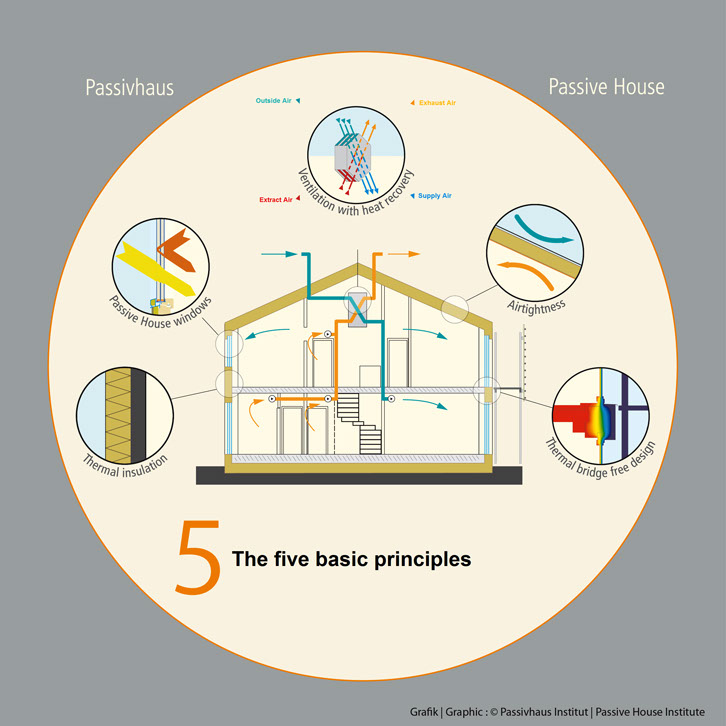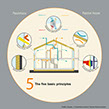What is a Passivhaus
The Passivhaus Standard
The Passivhaus Standard was established by a German physicist Wolfgang Feist in the 1980s and the buildings has been monitored, over the years the outcomes have been refined and it has become the world’s leading energy design standard and one of the only certified low energy building standards.
The primary focus in building to the Passivhaus Standard is directed towards creating a thermally efficient envelope which makes the optimum use of free heat gains in order to minimise space heating requirement. in good comfort conditions during winter and summer, without traditional space heating systems.
The building physics is centred on Comfort, Air Quality and Wellbeing, making sure they are very healthy houses to live in. A passive house provides a very high level of thermal comfort and whole-house even temperature. The concept is based on minimising heat losses and maximising solar heat gains, thus enabling the use of simple building services.
Over 20,000 buildings of different types including dwellings, schools, offices and sport halls have been built to the Passivhaus standard.
They are extremely cost effective to run and often called the 1.5 litre house, and could be heated by the equivalent of 1.5 litres of heating oil, i.e. 15 kWh of thermal energy per m2 per year, or 75p per m2 per year (based on a price for heating oil of 50p a litre)
A PassivHaus doesn’t need a conventional heating or cooling system and the heating demand is less than 15kWh/m²y which is 90% less than average.
All the elements of the building need to work well together, no thermal bridges, highly insulated external envelope (walls, windows, and doors), and uses internal heat sources and efficient mechanical ventilation with heat recovery.
Structural airtightness (reduction of air infiltration) and minimal thermal bridging are essential. A whole-house mechanical heat recovery ventilation system (MHRV) is used to supply controlled amounts of fresh air to the house.
The incoming fresh air is pre-heated, via a heat exchanger, by the outgoing warm stale air. If additional heat is required, a small efficient back-up system (using a renewable energy source, for example) can be used to boost the temperature of the fresh air supplied to the house.
In order to maintain high comfort levels in any building, heat losses must be replaced by heat gains. Heat losses occur through the building fabric due to transmission through poorly insulated walls, floor, ceiling and glazing as well as from uncontrolled cold air infiltration through leaky construction and poorly fitted windows and doors. In a passive house, the heat losses are reduced dramatically (through better insulation and airtight detailing) so that internal gains and passive solar gain contribute a relatively high proportion of the total need. As a result of this, a smaller space heating system is therefore required compared to that needed in a conventional poorly performing dwelling.
The energy requirement of a house retrofitted to the full Passivhaus Standard is:
Probably the hardest of all the standards to achieve is the air-leakage, as so much heat is lost just by the warm air leaking from the building and the test results must not exceed 0.6 air changes per hour (ac/hr) and is more stringent than is currently normal in the UK as the test uses 50 Pascal both in over-pressurisation and under-pressurisation testing.
The EnerPHit Standard
This standard is for upgrading existing buildings as it is often not possible to meet the stringent requirements of PassivHaus for a new build when refurbishing an existing property, and make the building to free of cold bridges.
The energy necessity of a house refurbishment to the EnerPHit Standard is:
Annual space heating requirement of 25 kWh/(m2a) treated floor area;
The upper limit for total primary energy demand for space and water heating, ventilation, electricity for fans and pumps, household appliances, and lighting not exceeding 120 kWh/(m2a), regardless of energy source; and
The frequency of Excessive internal temperature, this more than 25 °C, should be limited to below 10 % and is recommended that it is less than 5 %.
Additionally, the air-leakage test results must not exceed 1.0 air changes per hour (ac/hr) using 50 Pascal over-pressurisation and under-pressurisation testing.
Thermal Modelling
A thermal bridge is simply when materials that have a poor at insulation quality and are exposed to the outside temperature, there for allowing heat to flow directly to the outside.
In low energy buildings, specifically PassivHaus, remarkably about 20% of the total heating requirement can be used just through the junctions of the building.
The best way to avoid this is by carefully designing the building to prevent these losses.
Normally there are two types of thermal bridge, and these can be characterised as either repeating, where for instance roof trusses reach the outside of the building, and Non-repeating and his can be described at the foundation of the building.
What’s a ‘Y’ factor?
This is a default heat loss coefficient (U value) for junctions. It’s an estimate expressed as a the amount of watts lost per linier metre.
In SAP these either have to be calculated or a value of 0.15 w/m, simply this means that 100m of cold bridge will add 15 watts to the overall heat load. This might seem like a small amount but most buildings have many 100m of potential bridge conditions, for instance windows, doors, foundations, roofs, first floors, and party walls etc..
The ideal option is to work out all of the heat losses through each thermal bridge and to add them all up and enter the data into the thermal calculation.
x
Passivhaus
GET IN TOUCH
Set up your free consultation by filling our quick form:
One of our business consultation specialists will be in touch with you within 24 hours.
Get Connected:










